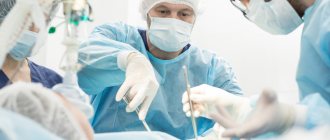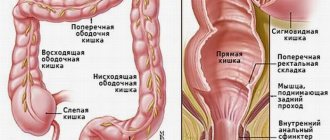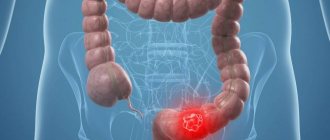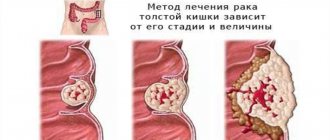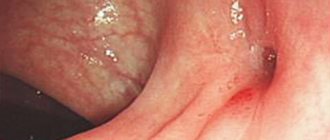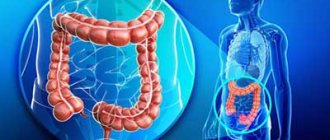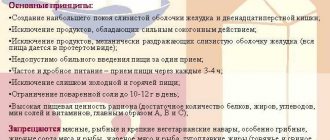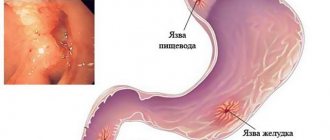Description and characteristics
Diverticulosis of the sigmoid colon is a disease of the descending colon with the formation of a large number of specific diverticula. These formations are growths on the walls of the intestine that resemble pouches. Appear as a result of strong stress when visiting the toilet.
Diverticula are usually located in the lower colon. Their sizes are small - like peas, but sometimes there are larger growths. They may occur due to increased flatulence or pressure of fecal masses on the internal walls of the intestine.
The disease is considered age-related. It has been called a “modern disease of society.” Most adult patients with intestinal diverticula live in large urban cities, where the prevailing trend of Western nutrition is the consumption of starchy and refined foods that are harmful to health.
Diverticulosis and diverticulitis
What is a diverticulum?
Due to disruption of innervation and nutrition, thinning of small areas of the colon mucosa (1–2 cm) occurs. Under the influence of pressure from the feces from the inside, the wall in these places stretches and protrudes outward, forming saccular formations, diverticula. Multiple lesions are called diverticulosis.
They can occasionally occur throughout the large intestine, but are most common in the sigmoid colon.
What causes the disorder?
Let's consider the provoking factors that cause diverticulosis of the sigmoid colon. These are changes associated with age, when the muscles of the intestinal wall become weak and the digestive organs begin to degenerate.
Another reason leading to the appearance of diverticula is underdeveloped or weakened connective tissue. The condition may appear at birth or after a failure in the formation of collagen fibers in the body.
Diverticulosis often appears against the background of disruptions in intestinal motility. The damage manifests itself in the fact that with high pressure in the intestinal cavity, the fibers of the walls are weakened, and specific protrusions called diverticula appear on them.
Diverticula can appear due to spasm of the muscle tissue of the intestinal wall. Such manifestations cause compression of the intestinal vessels and disruption of blood circulation. As a result, the space next to the vessels atrophies, stretch marks appear, from which diverticula grow inside the intestine.
Diverticulosis is often inherited. The risk of getting sick increases several times if the older generation of the family has problems with diverticula. Diet plays a major role in the development of pathology. Many studies have confirmed that in African countries, where people have been eating plant foods for a long time, diverticulosis is much less common than in the West, where people prefer animal products.
The use of traditional methods in the treatment of diverticulosis
Treatment of diverticula of the sigmoid colon with folk remedies is often used by many patients and gives quite good results. When treating a disease, it is first necessary to establish the process of defecation.
To do this, patients are recommended to introduce oatmeal jelly into their diet.
To prepare them, you need to take 2.5 - 3 liters of warm (50 - 60 degrees) boiled water, adding 150 - 160 ml of kefir mixed with 500 grams of oatmeal. Cover the bowl with the prepared mixture with a clean towel and leave it like that for 2 days.
After this time, the prepared mixture begins to ferment. Now the contents need to be strained.
The water that was obtained during the filtering process is diluted with cold water in the amount of 1.5 - 1.8 liters. The newly prepared mixture should be allowed to brew again for 20 - 24 hours.
After this, the liquid will separate into two parts. Oatmeal jelly will be prepared from the liquid that is at the bottom of the dish. Cold water is added to it, and after the jelly has boiled down, you can add butter, sugar or salt to taste.
Rose hip decoction
You can also prepare a herbal solution, which includes dry dill and rose hips, crushed in a blender.
The components must be taken in equal quantities.
In addition to these ingredients, you can also add chamomile, nettle or motherwort to the infusion.
Pour boiling water over everything and let it brew for 2 – 2.5 hours.
The prepared solution should be taken 150–160 ml twice a day with meals. The course of treatment lasts approximately 1.5 -2 months.
In order to cleanse the intestines, you can prepare sprouted wheat grains and green apples, crushed in a blender. It is advisable to take the finished mixture 200–300 grams instead of breakfast for 30 days.
Then you need to take a break of 30 days and start the procedure again.
Good results can be achieved by taking bran, which prevents the development of the inflammatory process in diverticulosis, reduces pain and stops metabolism. When using this method, you need to start with a small amount of bran and gradually increase it.
To prepare, you need to wash down the bran with kefir or yogurt. You can consume no more than 50–60 grams of bran per day.
Equally important in the treatment of diverticulosis of the sigmoid colon is the consumption of the required amount of fiber. If you don’t get enough of it in your food supply, you can make up for it by eating psyllium seeds, one of the most famous sources of fiber.
With regular consumption of the seeds of this plant, patients are able to restore the functioning of the digestive system almost 100%. To prepare, you need to pour 1 tbsp. l. seeds 200 - 250 ml of water, stir and drink immediately.
In the intestines, the seeds swell, increase in size approximately 5 times, and envelop the intestinal mucosa. The course of treatment lasts until the symptoms of the disease disappear completely.
With exactly the same success, you can take flax seeds in the same way.
Drinking mint tea helps to significantly reduce the pain associated with diverticulosis, and the metabolic process practically disappears. To do this, just add a few peppermint leaves to regular brewed tea.
The process of treating diverticulosis is inextricably linked with regular bowel cleansing. To do this, you can successfully use not only enemas, but also a tincture prepared from twigs or leaves of thorns.
To prepare the decoction you need to take 2 - 3 tbsp. l. mixture and pour 1 liter of boiling water over the mixture. This decoction should be drunk approximately 1 tbsp. within 24 hours. This is enough for the patient’s intestines to be completely cleansed within 2 to 5 days.
When the inflammatory process develops around the diverticulum, experts recommend taking an infusion of components such as mistletoe, peony, and nettle, filled with cold water.
Bring the mixture to a boil and let it brew. This decoction should be taken 1 tbsp. every morning and evening.
According to patient reviews, treatment of diverticulosis with folk remedies has good results. But, in no case should you neglect the preliminary consultation of specialists. In addition, after completing the course of treatment using folk remedies, each patient must undergo an intermediate examination, which will show the degree of development of diverticulosis of the sigmoid colon.
Diverticulosis: classification
Diverticulosis is divided into types:
- Asymptomatic disease. The patient does not notice the typical signs of the disease. Diverticula become noticeable only during a diagnostic examination or detection of other pathologies.
- Acute variety. This type of disease occurs with severe spasms in the intestines, disruptions in digestion and within the intestinal cavity.
- Complicated form of the disease. In this case, the patient needs urgent help.
Classes of complicated diverticulosis:
- Diverticulitis - occurs when stool accumulates in diverticula, which provokes the proliferation of microorganisms and the penetration of infections.
- Infiltrate of peri-intestinal type. It can happen due to inflammation in the abdominal organs, the appearance of a crack in the diverticulum.
- Diverticulosis can perforate. If perforation occurs in the peritoneum, this leads to peritonitis, and if in the mesentery, intestinal phlegmon develops.
- Intestinal fistula - if a purulent diverticulum has opened onto the peritoneal wall or another organ. Due to suppuration, fistulas appear externally or internally. Need surgical removal.
- Bleeding in the intestines. Damage to the mucous membrane from hardened feces causes vascular injury and blood loss during bowel movements.
Diverticulosis can be false or true. The true variety is congenital and develops due to protrusion of all intestinal layers.
A false disease is acquired diverticulosis, which appears during the process of growing up or aging.
Diverticula can be multiple or single. Their shape is ambiguous: there are growths in the form of a pear, an elongated ball, an oval, etc. The sizes are different. The smaller the hole in width, the higher the risk of accumulation of fecal deposits in diverticular neoplasms, which becomes the beginning of the inflammatory process.

